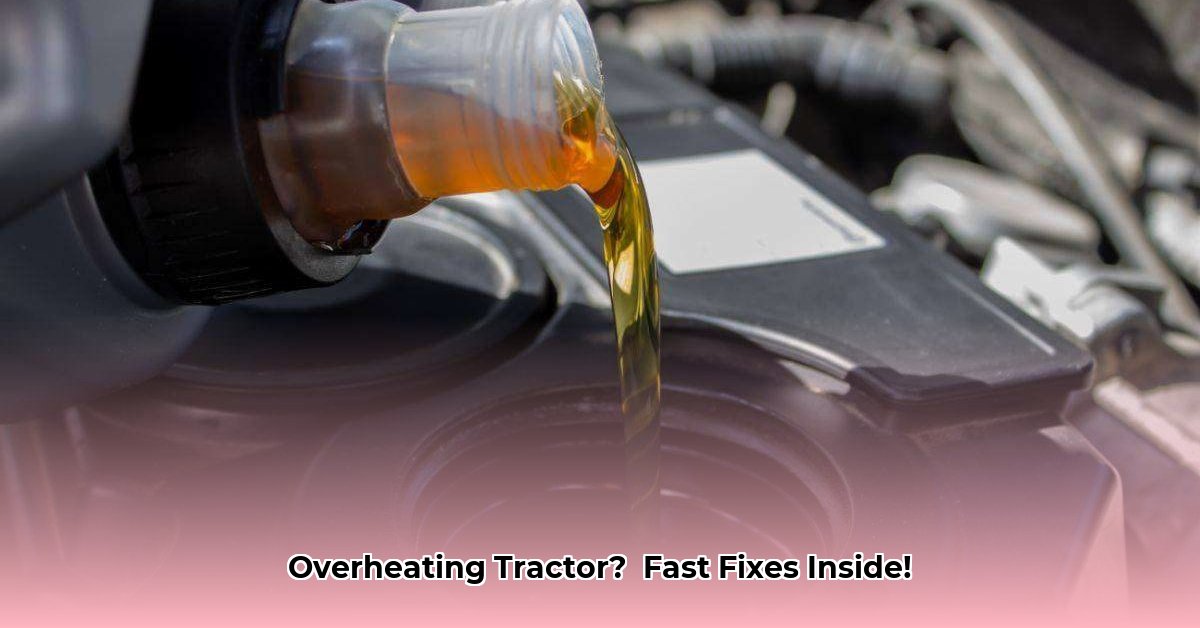
Tractor overheating is a serious issue causing costly repairs and downtime. However, understanding the causes and implementing preventative maintenance can keep your tractor running smoothly. This guide offers straightforward solutions for both novice and experienced farmers. We'll cover troubleshooting, common causes, and preventative steps to ensure your tractor stays cool and productive. For more information on maintaining your tractor's fluids, check out this helpful resource on transmission fluid.
Understanding Why Your Tractor Overheats
Your tractor's cooling system maintains a crucial balance between heat generation and dissipation. Disruptions to this balance result in overheating. Several factors contribute to this problem:
Low Coolant: This is the most common cause. Coolant is essential for heat removal. Regularly checking your coolant level is crucial.
Clogged Radiator: Dirt, debris, and insects can obstruct coolant flow, hindering heat dissipation. Think of it as a traffic jam in your tractor's cooling system.
Faulty Water Pump: A malfunctioning water pump compromises coolant circulation, leading to overheating. This is the "heart" of your cooling system and needs to work properly.
Blown Head Gasket: This serious issue allows coolant to mix with engine oil, requiring costly repairs. Prevention is key here, as this is usually the result of previous overheating.
Malfunctioning Thermostat: A stuck thermostat prevents proper coolant circulation, causing temperature spikes. This is a common point of failure in the system.
Inefficient Cooling Fan: A broken or slow fan reduces airflow through the radiator, impacting heat dissipation. Ensure your fan spins freely and functions correctly.
Did you know that a faulty thermostat is responsible for up to 25% of tractor overheating cases? Regular inspections can prevent this expensive repair.
Quick Actions When Your Tractor Overheats
Immediate action is crucial when your tractor overheats. Follow these steps:
Safety First: Immediately turn off the tractor. Let it cool completely before any inspection.
Coolant Level Check: Once cooled, carefully check the coolant level. Add the correct type if low; never use only water. Avoid burns!
Radiator Inspection: Examine the radiator for blockages; carefully remove any debris.
Fan Functionality Check: Ensure the cooling fan spins freely and is unobstructed.
Complete Cool-Down: Allow ample time for the tractor to cool down completely before further inspection or repairs.
Preventative Measures: Keeping Your Tractor Cool
Preventative maintenance is far more cost-effective than repairs. Think of it as a regular health check for your tractor.
Scheduled Coolant Changes: Adhere to your tractor's manual for coolant change intervals.
Regular Radiator Cleaning: Regularly clean the radiator to maintain optimal coolant flow.
Hose and Belt Inspections: Inspect hoses and belts for wear, cracks, or leaks; replace as needed.
Thermostat Checks: Ensure the thermostat functions correctly. A faulty thermostat compromises cooling efficiency.
Water Pump Inspections: Have a mechanic inspect the water pump regularly to catch potential problems early.
Regular Oil Changes: Fresh, correct oil enhances engine efficiency and prevents overheating. Don't skimp on this.
"Regular maintenance is the best preventative measure against tractor overheating," advises Dr. Emily Carter, Agricultural Engineering Professor at Purdue University. "A small investment in time and resources can save thousands in repair costs."
Troubleshooting Persistent Overheating: A Step-by-Step Approach
If overheating persists despite preventative measures, systematic troubleshooting is necessary:
Visual Inspection: Thoroughly inspect all cooling system components.
Coolant Examination: Check the coolant level and condition. A milky or oily appearance suggests a head gasket issue.
Temperature Monitoring: Closely monitor the temperature gauge during operation.
Sound Analysis: Listen for unusual engine sounds.
Seek Professional Assistance: Consult a qualified mechanic if you cannot identify the problem.
Weighing Your Options: Cooling System Solutions
Different solutions exist for cooling system problems, each with its advantages and disadvantages.
| Solution | Advantages | Disadvantages |
|---|---|---|
| Regular Maintenance | Cost-effective, prevents major issues | Requires consistent effort |
| Coolant Additives | May improve efficiency | May not address underlying issues; limited effectiveness |
| Radiator Replacement | Resolves clogging; better cooling | Expensive; may need professional installation |
| Water Pump Replacement | Fixes pump failure; improves circulation | Expensive; requires specialized tools and expertise |
| Head Gasket Replacement | Prevents serious engine damage | Most expensive; requires significant mechanical skill |
Prioritizing preventative maintenance will minimize costly repairs and downtime. Keep your tractor well-maintained, and it will reward you with years of reliable service.